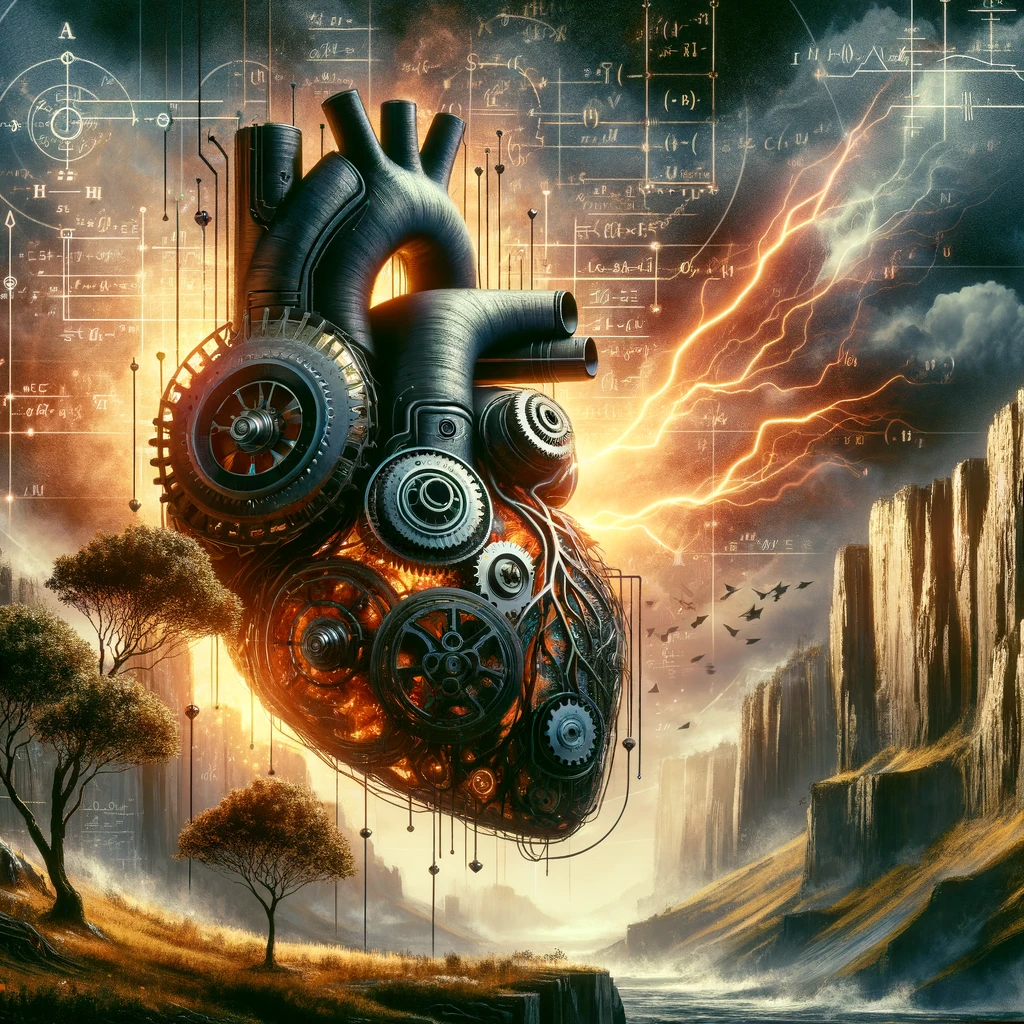Engineering

When Science and Creativity Entwine in Love
Engineering involves the application of scientific principles to design, create, and optimize systems, products, and processes. At the same time, creativity plays a crucial role in the engineering process, especially when it comes to problem-solving, innovation, and the development of novel solutions.
Here’s how engineering incorporates both science and creativity:
Scientific Foundation: Engineering is built upon a solid foundation of scientific principles, including physics, mathematics, chemistry, and biology. Engineers use these principles to understand the natural world and the behavior of materials, energy, and forces.
Problem-Solving with Creativity: Engineers often encounter complex and multifaceted problems that require creative thinking to devise effective solutions. Creativity allows engineers to approach problems from different angles, consider unconventional solutions, and adapt to unforeseen challenges.
Innovation and Design: Creative thinking is integral to the design process in engineering. Engineers must envision new products, systems, or structures and find innovative ways to meet specific needs or address problems.
Optimization and Efficiency: While the scientific aspect of engineering involves understanding the fundamental laws and principles, creativity comes into play when optimizing designs for efficiency, cost-effectiveness, and sustainability. Engineers must balance various constraints to achieve optimal solutions.
Interdisciplinary Nature: Many engineering projects require collaboration across different scientific disciplines. Creativity is vital when integrating knowledge from diverse areas to create holistic and effective solutions.
Prototyping and Experimentation: Engineers often engage in prototyping and experimentation to test and refine their designs. This iterative process involves creativity in identifying and implementing improvements based on trial and error.
Human-Centered Design: In fields like industrial design and user experience engineering, creativity is essential for creating products and systems that are not only functional but also user-friendly and aesthetically pleasing.
Emerging Technologies: With the rapid advancement of technology, engineers need creative thinking to stay at the forefront of innovation. Creative problem-solving is crucial when working on cutting-edge technologies and exploring new possibilities.
In essence, engineering is a dynamic field that combines scientific knowledge with creative thinking to address real-world challenges and contribute to technological advancements. The integration of science and creativity is what allows engineers to devise solutions that are not only technically sound but also innovative and practical.
A meeting of the minds... or more accurately,
the integration of one mind

Brings into existence a new idea or concept
Overlap: While critical and creative thinking may seem distinct, there is often overlap. Critical thinking is involved in assessing the viability and effectiveness of creative ideas, and creative thinking can contribute to generating novel solutions during critical analysis.
Balance: Effective thinking often requires a balance between critical and creative approaches. Critical thinking ensures rigor and logical analysis, while creative thinking injects innovation and originality into problem-solving.
Applications:
- Critical Thinking: Applied in areas such as academic analysis, scientific research, legal reasoning, and strategic planning.
- Creative Thinking: Applied in fields like art, design, entrepreneurship, and problem-solving in situations that benefit from fresh and imaginative solutions.
Both critical and creative thinking are valuable skills, and individuals often benefit from cultivating a balance between these cognitive processes for more well-rounded and effective thinking.
Critical thinking and creative thinking are complementary cognitive processes that involve different aspects of mental activity. Both are essential skills for problem-solving, decision-making, and overall intellectual growth. Here’s a description of each:
Critical Thinking:
- Definition: Critical thinking is the ability to analyze, evaluate, and synthesize information objectively and logically. It involves questioning assumptions, considering evidence, and making reasoned judgments.
- Key Characteristics:
- Logical Analysis: Critical thinkers examine information systematically, identifying patterns, relationships, and logical connections.
- Evidence-Based: They rely on evidence and sound reasoning to form conclusions rather than accepting information uncritically.
- Skepticism: Critical thinkers approach information with a healthy skepticism, questioning assumptions and seeking alternative viewpoints.
- Problem Solving: Critical thinking is crucial for effective problem-solving, as it involves identifying problems, analyzing their components, and developing solutions.
Creative Thinking:
- Definition: Creative thinking is the ability to generate original, novel, and innovative ideas. It involves looking beyond conventional solutions, making unique connections, and exploring possibilities.
- Key Characteristics:
- Imagination: Creative thinkers have a vivid imagination, allowing them to envision new ideas, concepts, or solutions.
- Divergent Thinking: They excel at divergent thinking, producing a variety of ideas and exploring different possibilities in response to a stimulus.
- Playfulness: Creativity often involves a playful and open-minded approach to problem-solving, allowing for experimentation and exploration.
- Flexibility: Creative thinkers are adaptable, willing to consider unconventional perspectives and approaches.
The dawn of a new beginning is just over the horizon

Creative thinking holds significant value in the professional world across various industries and job roles
Creative thinking is the ability to generate novel and valuable ideas, solutions, or insights by approaching problems, situations, or tasks in unconventional ways. It involves breaking away from conventional thought patterns, exploring diverse perspectives, and making unexpected connections. Creative thinking is not limited to artistic pursuits; it is a valuable skill applicable to problem-solving in various domains, including science, business, and everyday life.
Key characteristics of creative thinking include:
Open-mindedness: Creative thinkers are open to new ideas, experiences, and perspectives. They embrace uncertainty and are willing to explore unconventional solutions.
Curiosity: A curious mindset drives creative thinking. Creative individuals are naturally inquisitive, always seeking to understand the world around them and eager to learn.
Imagination: Imagination is a central component of creative thinking. It involves the ability to visualize, conceptualize, and generate mental images or ideas that go beyond the immediate reality.
Flexibility: Creative thinkers are adaptable and flexible in their thinking. They are willing to shift perspectives, change approaches, and explore multiple avenues to find innovative solutions.
Risk-Taking: Creative thinking often involves taking risks and stepping outside one’s comfort zone. This willingness to take risks is crucial for exploring new ideas that may lead to breakthroughs.
Divergent Thinking: Divergent thinking refers to the ability to generate a variety of ideas in response to a stimulus or problem. It involves thinking expansively and considering multiple possibilities.
Resilience: Creative individuals are resilient in the face of challenges and setbacks. They view obstacles as opportunities for learning and growth rather than insurmountable barriers.
Playfulness: Playfulness is an element of creative thinking, allowing individuals to approach problems with a sense of enjoyment and experimentation. Playful exploration can lead to unexpected and innovative ideas.
Associative Thinking: Creative thinkers excel at making connections between seemingly unrelated concepts. They draw on diverse knowledge and experiences to find unique associations.
Originality: Originality is a hallmark of creative thinking. Creative individuals produce ideas or solutions that are not simply repetitions of existing concepts but represent a departure from the norm.
Creative thinking can be fostered and developed through various techniques, exercises, and a supportive environment that encourages experimentation. It is a valuable skill for individuals, teams, and organizations seeking to innovate and solve complex problems in unique ways.
Organizations that encourage and harness the creative potential of their employees are better positioned to thrive in a competitive and ever-changing business landscape.

The ability of a free spirit to soar with creativity
some studies and theories suggest that a positive emotional state, including a lack of guilt or stress, can contribute to enhanced creativity. However, it’s essential to note that creativity is a complex and multifaceted phenomenon influenced by various factors.
Here are some points to consider:
-
Positive Emotions and Creativity: Research in positive psychology has explored the link between positive emotions and creativity. Broadly speaking, positive emotions are associated with increased cognitive flexibility and the ability to consider a broader range of ideas.
-
Reduction of Stress and Anxiety: High levels of stress, anxiety, or guilt can be detrimental to cognitive processes, including creativity. Chronic stress may impair certain cognitive functions, while a relaxed state may foster a more open and exploratory mindset.
-
Mind-Wandering and Incubation: Creativity often involves divergent thinking, and a relaxed, guilt-free state may facilitate mind-wandering and incubation periods. These states allow the brain to make new connections and associations, contributing to creative insights.
-
Enhanced Problem-Solving: Guilt or problems can be distracting and may shift cognitive resources toward resolving immediate concerns. In a more relaxed state, individuals may have the mental bandwidth to engage in broader and more exploratory thinking.
-
Individual Differences: It’s crucial to recognize that individual differences play a significant role. Some people may find that a certain level of pressure or challenge enhances their creativity, while others may thrive in a more relaxed environment.
-
Environmental Factors: The work environment and organizational culture can influence creativity. Environments that foster positive emotions, collaboration, and a sense of autonomy may contribute to a more creative atmosphere.
-
Rest and Sleep: Adequate rest and sleep are essential for cognitive function, including creativity. Fatigue and sleep deprivation can negatively impact cognitive performance, while well-rested individuals may experience improved creativity.
While some studies support the idea that a positive emotional state can enhance creativity, the relationship is complex, and other factors, including individual differences, play a role. Additionally, there’s ongoing research in the field of psychology and neuroscience to better understand the intricacies of creativity and the impact of various emotional states.

Above: AI’s rendition of Creativity and Science entwining in Love.
